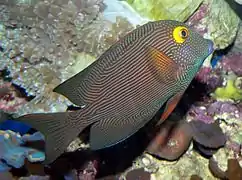Ctenochaetus strigosus
Ctenochaetus strigosus, the kole tang, spotted bristletooth, spotted surgeonfish, goldring bristletooth, goldring surgeonfish, yelloweye tang or yellow-eyed surgeonfish, is a species of marine ray-finned fish belonging to family Acanthuridae which includes the surgeonfishes, unicoornfishes and tangs. This fish is endemic to Hawaii.
| Ctenochaetus strigosus | |
|---|---|
 | |
| Scientific classification | |
| Domain: | Eukaryota |
| Kingdom: | Animalia |
| Phylum: | Chordata |
| Class: | Actinopterygii |
| Order: | Acanthuriformes |
| Family: | Acanthuridae |
| Genus: | Ctenochaetus |
| Species: | C. strigosus |
| Binomial name | |
| Ctenochaetus strigosus (E. T. Bennett, 1828) | |
| Synonyms[2] | |
| |
Taxonomy
Ctenochaetus strigosus was first formally described in 1828 as Acanthurus strigosus by the English zoologist Edward Turner Bennett with its type locality given as the Sandwich Islands.[3] In 1884 Theodore Gill classified A. strigosus in the new monospecific genus Ctenochaetus, meaning that it is the type species of that genus by monotypy.[4] The genera Ctenochaetus and Acanthurus make up the tribe Acanthurini which is one of three tribes in the subfamily Acanthurinae which is one of two subfamilies in the family Acanthuridae.[5]
Etymology
Ctenochaetus strigosus has the specific name strigosus, meaning "slender", probably an allusion to the many thin bristle-like teeth of this fish.[6]
Description
Ctenochaetus strigosus has its dorsal fin supported by 8 spines and between 25 and 28 soft rays while its anal fin is supported by 3 spines and 22 to 25 soft rays.[2] The body is laterally compressed and it has a small mouth. The overall color is purplish to brown with slender, longitudinal light blue lines and a yellow ring around the eyes.[7] This species has a maximum published standard length of 15 cm (5.9 in).[2]
Distribution and habitat
Ctenochaetus strigosus is endemic to the Hawaiian Islands and to Johnston Atoll in the United States Minor Outlying Islands.[1] It is a benthopelagic species found at depths between 1 and 113 m (3 ft 3 in and 370 ft 9 in) over coral, rock and rubble where it lives singly and feeds by sifting food, such as diatoms and algae, detritus in its bristle-like teeth.[2]
Utilization
Ctenochaetus strigosus is a popular fish in the aquarium trade, it is one of the most heavily collected species in that trade in Hawaii. It us also an important species in recreational fisheries.[1]
References
- Clements, K.D.; Choat, J.H.; Abesamis, R.; et al. (2012). "Ctenochaetus strigosus". IUCN Red List of Threatened Species. 2012: e.T177949A1500072. doi:10.2305/IUCN.UK.2012.RLTS.T177949A1500072.en. Retrieved 19 November 2021.
- Froese, Rainer; Pauly, Daniel (eds.) (2023). "Ctenochaetus strigosus" in FishBase. JUne 2023 version.
- Bennett, E. T. (1828). "Observations on the fishes contained in the collection of the Zoological Society. On some fishes from the Sandwich Islands". Zoological Journal, London. 4 (13): 31–42.
- Eschmeyer, William N.; Fricke, Ron & van der Laan, Richard (eds.). "Genera in the family Acanthuridae". Catalog of Fishes. California Academy of Sciences. Retrieved 9 October 2023.
- J. S. Nelson; T. C. Grande; M. V. H. Wilson (2016). Fishes of the World (5th ed.). Wiley. pp. 497–502. ISBN 978-1-118-34233-6.
- Christopher Scharpf & Kenneth J. Lazara, eds. (12 January 2021). "Order ACANTHURIFORMES (part 2): Families EPHIPPIDAE, LEIOGNATHIDAE, SCATOPHAGIDAE, ANTIGONIIDAE, SIGANIDAE, CAPROIDAE, LUVARIDAE, ZANCLIDAE and ACANTHURIDAE". The ETYFish Project Fish Name Etymology Database. Christopher Scharpf and Kenneth J. Lazara. Retrieved 9 October 2023.
- "Ctenochaetus strigosus". Saltcorner. Bob Goemans. Retrieved 9 October 2023.
